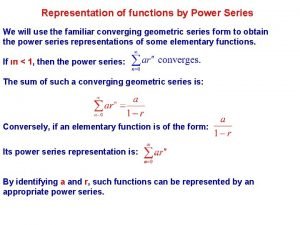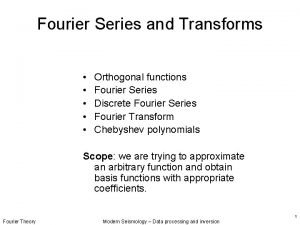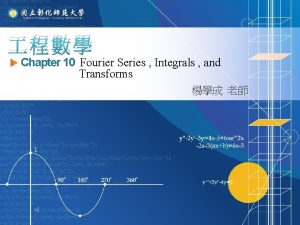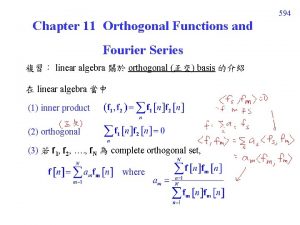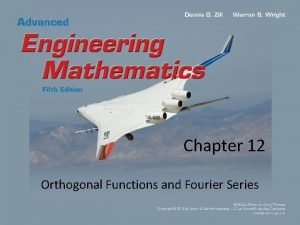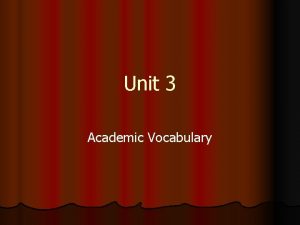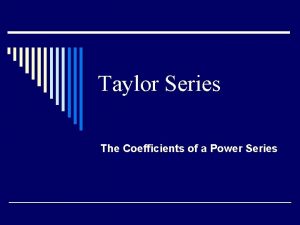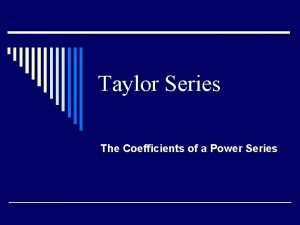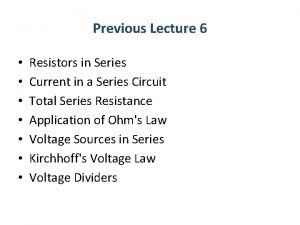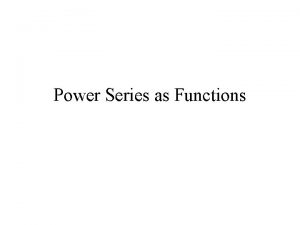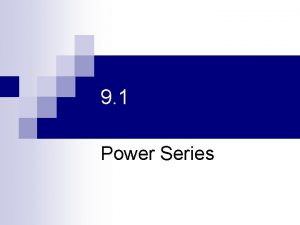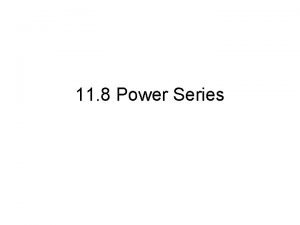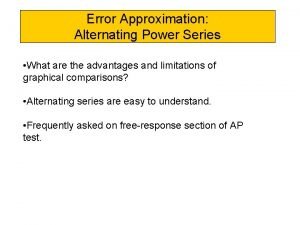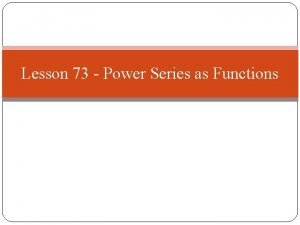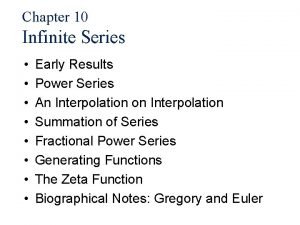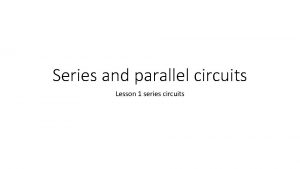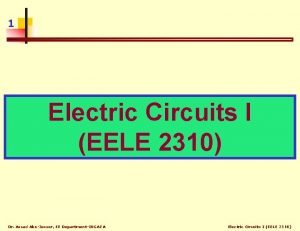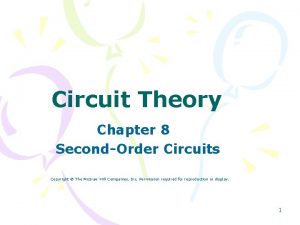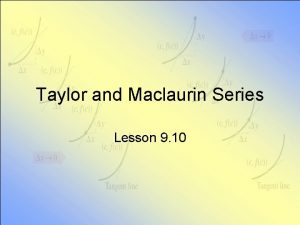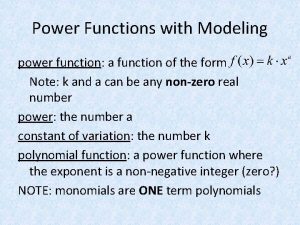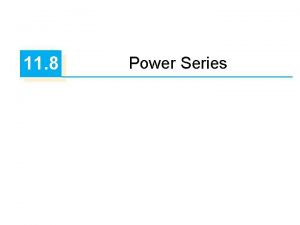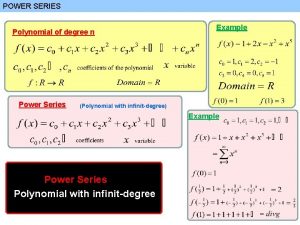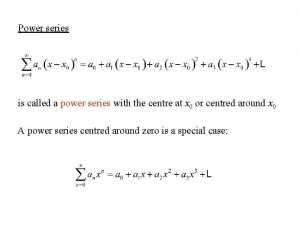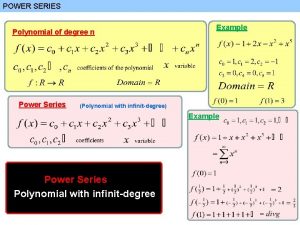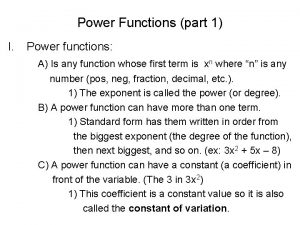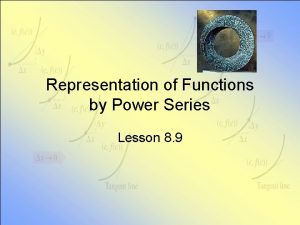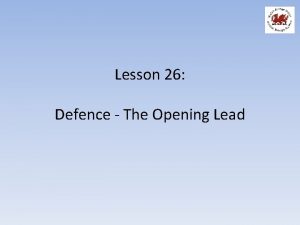Lesson 73 Power Series as Functions Opening Examples

















































- Slides: 49

Lesson 73 - Power Series as Functions

Opening Examples Determine the sums of the following series:

Lesson Objectives The main goal of our lesson for today is to consider the sorts of functions that are sums of Power Series: • What are these functions like? • Are power series functions continuous? Are they differentiable? Antidifferentiable? • Can we find formulas for them?

Example Consider the power series function The ratio test shows that the radius of convergence is ? So the series converges on What is the interval of convergence? (? , ? ) What about the endpoints? I = ? ? ?

Example To see this idea “in action, ” Consider the power series The ratio test shows that the radius of convergence is 2 So the series converges on What is the interval of convergence? (1, 5) What about the endpoints? I = [1, 5] The domain of the function

Example—Graphs! Now use DESMOS to graph the 30 th, 35 th, 40 th, and 45 th partial sums of the power series Remember that each partial sum is a polynomial. So we can plot it!

Example—Graphs! This graph shows the 30 th, 35 th, 40 th, and 45 th partial sums of the power series Do you see the graph of f emerging in the picture?

Formulas! Consider an (already familiar) Example Our old friend the geometric series! We know it converges to

Formulas! Consider an (already familiar) Example And our NEW friend, also a geometric series! And just exactly HOW the HECK is this a geometric series?

Formulas! Consider an (already familiar) Example Our old friend the geometric series since We know it converges to and diverges elsewhere. That is, r = x! whenever |x| < 1

Our first formula! We see the expected convergence on a “balanced” interval about x = 0. Near x = 1, the partial sums “blow up” giving us the asymptote we expect to see there. This plot shows the 10 th, 12 th, 13 th, and 15 th partial sums of this series. Near x = -1 the even and odd partial sums go opposite directions, preventing any convergence to the left of x = -1.

Example #1 Express as a power series and find its interval of convergence

Example #1

Example #2 Express as a power series and find its interval of convergence

Example #2

Example #3 Express as a power series and find its interval of convergence

Example #3

Example #4 Express as a power series and find its interval of convergence

Example #4

Example #5 Express as a power series and find its interval of convergence

Example #5

Example #6 Express as a power series and find its interval of convergence

Find a geometric power series for the function: Make this 1 Divide numerator and denominator by 4 a = 3/4 r = x/4 Use a and r to write the power series.

Find a geometric power series for the function: Let us obtain the interval of convergence for this power series. f(x) -4 < x < 4 Watch the graph of f(x) and the graph of the first four terms of the power series. The convergence of the two on (-4, 4) is obvious.

Example #7 Express as a power series centered at x = -2 and find its interval of convergence

Find a geometric power series centered at c = -2 for the function: The power series centered at c is: Divide numerator and denominator by 6 a=½ Make this 1 r – c = (x + 2)/6 f(x) x = -2

Example #8 Express as a power series centered at x = 2 and find its interval of convergence

Find a geometric power series centered at c = 2 for the function: Since c = 2, this x has to become x – 2 Divide by 3 to make this 1 Make this – to bring it to standard form Add 4 to compensate for subtracting 4

Find a geometric power series centered at c = 2 for the function: This series converges for: x=2

Example #9 Express as a power series and find its interval of convergence

Find a geometric power series centered at c = 0 for the function: We first obtain the power series for 4/(4 + x) and then replace x by x 2 Replace x by x 2 Make this – to bring it to standard form f(x)

Find a geometric power series centered at c = 0 for the function: We obtain power series for 1/(1 + x) and 1/(1 – x) and combine them. f(x) STOP HERE!

Example #10 ***** Express as a power series and find its interval of convergence

Our first formula! What else can we observe? Clearly this function is both continuous and differentiable on its interval of convergence. It is very tempting to say that the for f (x) = 1 + x 2 + x 3 +. . . derivative should be But is it? For that matter, does this series even converge? And if it does converge, what does it converge to?

The general form of the series is The ratio test limit: So the “derivative” series also converges on (-1, 1). We showed that it diverges at the endpoints.

Differentiating Power Series Does it converge to 6 th partial sum 10 th partial sum The green graph is the partial sum, the red graph is

This graph suggests a general principle: Theorem: (Derivatives and Antiderivatives of Power Series) Let be a power series with radius of convergence R > 0. And let And Then • Both D and A converge with radius of convergence R. • On the interval (x 0 – R , x 0+R) S’(x) = D(x). • On the interval (x 0 – R , x 0+R) A’(x) = S(x).

Or to put it more succinctly, if a little less precisely, Theorem: (Derivatives and Antiderivatives of Power Series) If is a power series with radius of convergence R > 0. Then we can differentiate and antidifferentiate S. Moreover, And These all have the same radius of convergence.

Lest we lose the forest for the trees. . . Let us consider again our original example from SLIDE #4 Even though we can’t find a formula for f, we can still differentiate and antidifferentiate it. What do we get?

Lest we lose the forest for the trees. . . Interval of Conv. What is the radius of convergence?

Example #11 Express as a power series and find its interval of convergence

Example #12 Express as a power series and find its interval of convergence

Find a geometric power series centered at c = 0 for the function: We obtain power series for 1/(1 + x) and integrate it Then integrate the power series for 1/(1 – x ) and combine both.

Find a geometric power series centered at c = 0 for the function: When x = 0, we have 0=0+c c=0

Example #13 Express as a power series and find its interval of convergence

Find a geometric power series centered at c = 0 for f(x) = ln(x 2 + 1) We obtain the power series for this and integrate. f(x) When x = 0, we have 0=0+c c=0 -1 < x < 1

Example #14 Express as a power series and find its interval of convergence

Find a power series for the function f(x) = arctan 2 x centered at c = 0 We obtain the power series for this and integrate. Replace x by 4 x 2

Find a power series for the function f(x) = arctan 2 x centered at c = 0 f(x) = arctan 2 x -0. 5 When x = 0, arctan 2 x = 0 0=0+c -0. 5 c=0
 Representations of functions as power series
Representations of functions as power series Shunt-series feedback amplifier
Shunt-series feedback amplifier Ac power formula
Ac power formula Maclaurin series vs taylor series
Maclaurin series vs taylor series Heisenberg 1925 paper
Heisenberg 1925 paper Maclaurin series vs taylor series
Maclaurin series vs taylor series Taylor series lesson
Taylor series lesson Ibm p series vs i series
Ibm p series vs i series Series aiding and series opposing
Series aiding and series opposing Arithmetic sequence formula
Arithmetic sequence formula Orthogonal functions in fourier series
Orthogonal functions in fourier series Complex fourier series
Complex fourier series Orthogonality of trigonometric functions
Orthogonality of trigonometric functions Fourier series and orthogonal functions
Fourier series and orthogonal functions Imagery definition and examples
Imagery definition and examples Open adjective example
Open adjective example What is drama/play
What is drama/play Sample opening statement examples
Sample opening statement examples Koiri pattern
Koiri pattern Policy statement mun example
Policy statement mun example Pistol offense playbook pdf
Pistol offense playbook pdf Taylors theorem
Taylors theorem Sinx power series
Sinx power series Power in series circuit
Power in series circuit Finite power series
Finite power series Summation of power series
Summation of power series Series fed class a power amplifier
Series fed class a power amplifier Integration of power series
Integration of power series Power series review
Power series review Ratio test on power series
Ratio test on power series Integration of power series
Integration of power series Power series
Power series Power series
Power series Neo go
Neo go How to make a power series
How to make a power series Power series 1/1+x
Power series 1/1+x Power series
Power series Power series neo go
Power series neo go Lesson 1: the series circuit
Lesson 1: the series circuit Lesson 8: comparing series and parallel rlc circuits
Lesson 8: comparing series and parallel rlc circuits Lesson 8: comparing series and parallel rlc circuits
Lesson 8: comparing series and parallel rlc circuits Lesson 4: arithmetic series
Lesson 4: arithmetic series Taylor series lesson
Taylor series lesson Absolute value piecewise function
Absolute value piecewise function Evaluating functions
Evaluating functions Evaluating functions and operations on functions
Evaluating functions and operations on functions Power function word problems
Power function word problems Power function vs polynomial function
Power function vs polynomial function Solar power satellites and microwave power transmission
Solar power satellites and microwave power transmission Actual power
Actual power
